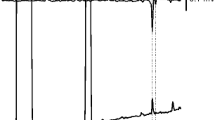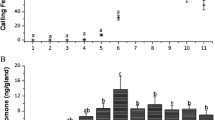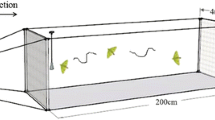Abstract
Hawk moths are classified into the subfamilies Sphinginae, Macroglossinae and Smerinthinae. The sex pheromones of hawk moths have been intensively investigated recently. However, these reports were mainly on Sphinginae and Macroglossinae and there are only a few reports on Smerinthinae. Here, we identified sex pheromone components from the Smerinthinae, Smerinthus tokyonis Matsumura (Lepidoptera: Sphingidae). Observation of female calling behavior showed that the behavior started immediately after the photo-phase started. Gas chromatography (GC) coupled with electroantennography detection analysis indicated that male antenna responded to three components in the pheromone gland extract. GC–MS and GC analyses demonstrated that the three components were (10Z,12E)–, (10E,12Z)–, and (10Z,12Z)–hexadecadienyl acetates in a 6:7:87 ratio. We subsequently performed behavioral assays in cages. We observed the orientation and contact behavior of males in response to different odor sources, including a solvent control, calling female, pheromone gland extract, and synthetic blend. Males did not respond to the solvent control, but did respond to the other sources. Since males responded more to the calling female than to the synthetic blend, additional cues seem to be required for complete mating behavior. Nevertheless, the pheromone components determined in this first study of a Smerinthinae species are important chemicals in mating communication.


Similar content being viewed by others
References
Bestmann HJ, Erler J, Garbe W, Kern F, Martischonok V, Schäfer D, Vostrowsky O, Wasserthal LT (1992) Pheromone components of the female elephant hawk-moth, Deilephila elpenor, and the silver-striped hawk-moth, Hippotion celerio. Experientia 48:610–613
Dool HD, Kratz PD (1963) A generalization of the retention index system including linear temperature programmed gas–liquid partition chromatography. J Chromatogr 11:463–471
Hothorn T, Bretz F, Westfall P (2008) Simultaneous inference in general parametric models. Biom J 50:346–363
Judd GJ, Eby C (2014) Spectral discrimination by Synanthedon myopaeformis (Lepidoptera: Sesiidae) when orienting to traps baited with sex pheromone or feeding attractants. Can Entomol 146:8–25
Kawahara AY, Barber JR (2015) Tempo and mode of anti-bat ultrasound production and sonar jamming in the diverse hawkmoth radiation. Proc Nat Acad Sci 112:6407–6412
Kawahara AY, Mignault AA, Regier JC, Kitching IJ, Mitter C (2009) Phylogeny and biogeography of hawkmoths (Lepidoptera: Sphingidae): evidence from five nuclear genes. PLoS ONE 4:e5719
Kawahara AY et al (2013) Evolution of Manduca sexta hornworms and relatives: biogeographical analysis reveals an ancestral diversification in Central America. Mol Phylogenet Evol 68:381–386
Kishida Y (2011) Sphingidae. In: Kishida Y (ed) The standard of moths in Japan I. Gakken Education Publishing, Tokyo, p 331 (in Japanese)
KonDo Y, Naka H, Tsuchida K (2012) Pheromones and body coloration affect mate recognition in the Japanese nine-spotted moth Amata fortunei (Lepidoptera: Arctiidae). J Ethol 30:301–308
Landolt PJ, Tumlinson JH, Brennan MM (1989) Attraction of Amphion floridensis (Lepidoptera: Sphingidae) to bombykal, (E, Z)-10,12-hexadecadienal. Fla Entomol 72:324–327
Namiki S, Daimon T, Iwatsuki C, Shimada T, Kanzaki R (2014) Antennal lobe organization and pheromone usage in bombycid moths. Biol Lett 10:20140096
Nieukerken EJ et al (2011) Order Lepidoptera Linnaeus, 1758. In: Zhang, Z.-Q. (Ed.) Animal biodiversity: an outline of higher-level classification and survey of taxonomic richness. Zootaxa 3148:212–221
Nirazawa T, Fujii T, Seki Y, Namiki S, Kazawa T, Kanzaki R, Ishikawa Y (2017) Morphology and physiology of antennal lobe projection neurons in the hawkmoth Agrius convolvuli. J Insect Physiol 98:214–222
Pittaway AR (1993) The hawkmoths of the western palaearctic. Harley books, Colchester
Ponce FV, Breinholt JW, Hossie T, Barber JR, Janzen DH, Hallwachs W, Kawahara AY (2015) A molecular phylogeny of Eumorpha (Lepidoptera: Sphingidae) and the evolution of anti-predator larval eyespots. Sys Entomol 40:401–408
R Core Team (2020). R: A language and environment for statistical computing. R Foundation for Statistical Computing, Vienna, Austria. URL https://www.R-project.org/.
Reed DW, Underhill EW, Giblin EM (1987) Attraction of sphingid moths (Lepidoptera: Sphingidae) to 10,12-hexadecadienyl aldehydes and acetates: evidence of pheromone components. J Chem Ecol 13:931–942
Tumlinson JH, Mitchell ER, Doolittle RE, Jackson DM (1994) Field tests of synthetic Manduca sexta sex pheromone. J Chem Ecol 20:579–591
Uehara T, Honda H (2020) Sex pheromone communication system in hawk moth. In: Ishikawa Y (ed) Insect sex pheromone research and beyond: from molecules to robots. Springer Entomology Monograph Series, pp 19–33
Uehara T, Naka H, Matsuyama S, Ando T, Honda H (2012) Identification and field evaluation of sex pheromones in two hawk moths Deilephila elpenor lewisii and Theretra oldenlandiae (Lepidoptera; Sphingidae). Appl Entomol Zool 47:227–232
Uehara T, Naka H, Matsuyama S, Vang LV, Ando T, Honda H (2013) Identification of conjugated pentadecadienals as sex pheromone components of the sphingid moth, Dolbina tancrei. J Chem Ecol 39:1441–1447
Uehara T, Naka H, Matsuyama S, Ando T, Honda H (2015) Identification of the sex pheromone of the diurnal hawk moth, Hemaris affinis. J Chem Ecol 41:9–14
Uehara T, Kitahara H, Naka H et al (2016) Single-component pheromone consisting of bombykal in a diurnal hawk moth, Neogurelca himachala sangaica. J Chem Ecol 42:517–522
Venables WN, Ripley BD (2002) Modern applied statistics with S, 4th edn. Springer, New York (ISBN 0-387-95457-0)
Wakamura S, Yasuda T, Watanabe M, Kiguchi K, Shimoda M, Ando T (1996) Sex pheromone of the sweetpotato hornworm, Agrius convolvuli (L.) (Lepidoptera: Sphingidae): identification of a major component and its activity in a wind tunnel. Appl Entomol Zool 31:171–174
Young DC, Vouros P, Holick MF (1990) Gas chromatography–mass spectrometry of conjugated dienes by derivatization with 4-methyl-1,2,4-triazoline-3,5-dione. J Chromatogr 522:295–302
Acknowledgements
This project was supported by Grants-in-Aid for JSPS Fellows and for Young Scientists (Start-up), JSPS KAKENHI Grant Number 15H06854. This research was in partial fulfillment of an MSc degree (AK) from the University of Tsukuba.
Author information
Authors and Affiliations
Corresponding author
Additional information
Publisher's Note
Springer Nature remains neutral with regard to jurisdictional claims in published maps and institutional affiliations.
Supplementary Information
Below is the link to the electronic supplementary material.
13355_2021_743_MOESM1_ESM.pptx
Supplementary Fig. 1. Electron ionization mass spectra of EAD-active component. A main EAD-active component (a) and MTAD derivative (b) (PPTX 80 KB)
Rights and permissions
About this article
Cite this article
Kosaki, A., Uehara, T., Naka, H. et al. Identification and behavioral assays of sex pheromone components in Smerinthus tokyonis (Lepidoptera: Sphingidae). Appl Entomol Zool 56, 373–378 (2021). https://doi.org/10.1007/s13355-021-00743-9
Received:
Accepted:
Published:
Issue Date:
DOI: https://doi.org/10.1007/s13355-021-00743-9




